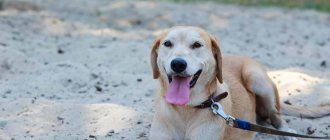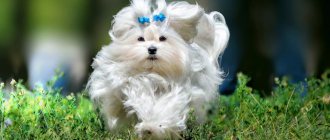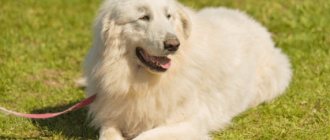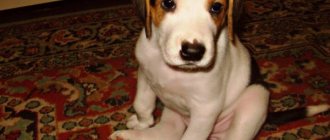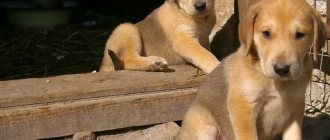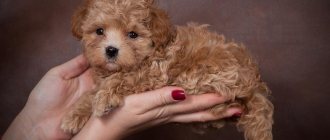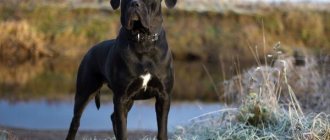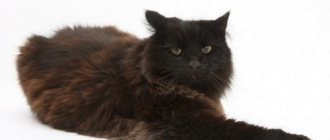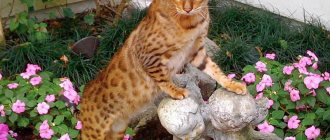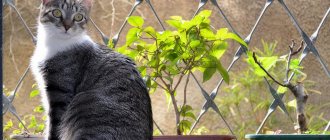It's no secret that the main entertainment of the aristocratic nobility in Tsarist Russia was hunting, so elite breeds of hunting dogs were held in high esteem. This means that there was a need to breed new breeds and improve old ones. It is worth saying that the work of the breeders was not in vain, and such a breed of dog was bred as the Russian Piebald Hound (RPG).
- 2 Features of the appearance and character of the Russian pet
2.1 Breed standard - 2.2 Pet character
- 4.1 Video: Russian pinto puppies on a walk
- 5.1 Training and raising a pet
5.1.1 Video: RPG while hunting a hare
A brief excursion into the history of the breed
At the moment, it has not been possible to find out where these hounds came from in Russia. It is believed that their historical homeland is the Mongol-Tatar Khanate, and they came to us during the period of the yoke. That is why the breed is sometimes called the eastern hound.
Russian hound
The second theory is that the Russian hound dog was bred as a result of natural crossing of native huskies with pointers brought from the east. The formation of the breed phenotype was completed at the beginning of the 20th century, but the Civil War and the Second World War had a negative impact on the number of animals. The breed was endangered. In peacetime, it had to be revived almost from scratch.
Note! Now the hunting hound is widely popular, but the FCI is not recognized.
From the Gauls to the present day
As Roman authors testify, already the first French kings (around the 3rd century AD) had very large packs of hound dogs. They hunted such large and strong animals as bears, wild boars, moose, aurochs, and bison. They were driven to the point of exhaustion, which in French sounds like par force, that is, “by force.” After the animals fell, they were finished off with arrows, spears or darts.
The implementation of such a grandiose action entailed the need to maintain a large number of hound dogs, vicious and strong. When the hunt for foxes, wolves and hares took place, hunters on horseback were also needed. At first, the game was driven out of the forest by hounds to the edge of the field, where horse-drawn hunters waited for it along with the hounds in packs.
According to medieval chronicles, in France alone in the 14th century there were more than 20 thousand hunters with hounds. Gradually, French breeds of hound dogs began to “emerge” (under Louis IX), among which there are four main ones. This:
- royal whites,
- St. Hubert's - black,
- Saint Louis - gray,
- Breton redheads.
General description of the breed
Bloodhound (hound dog): description of the breed
The Russian hound dog standard was adopted in 1925. This animal with an elongated body and above average height, its appearance resembles a wolf and looks very interesting. Distinctive features:
- Height – 55-64 cm (females), 58-67 cm (males).
- Weight – 25-30 kg.
- Dry wedge-shaped head, proportional to the body.
- The muzzle is elongated, ending with a black nose.
- Drop ears in the shape of triangles.
- The eyes are slanted, always brown in color and with dark eyelids.
- The neck is set low.
- Wide loin, developed withers.
- The paws are strong and strong.
- The tail, thick at the base, tapers to the tip and is lowered.
- The coat is short, with a thick light undercoat. On the body the fur is longer and forms a “scruff”.
Note! Color options: underhair, black-backed, crimson. Small patches of white fur on the chest are allowed.
There are several breed varieties of hounds. This is a Russian piebald hound, used to hunt wolves, roe deer, and hares. The large Anglo-French hound is rare.
Breed standard
Disqualifying faults
Some puppies may be born with defects that are not allowed by the standard. These include:
- The presence of folds of skin on the head and neck.
- Dense maroon color.
- Humps or curvature of the muzzle.
- Eye color blue, green or eyes of different colors.
- Tangled tail.
- Lack of undercoat, wavy coat.
- The nose is not black.
These are the main deviations, but there are other defects for which the dog is rejected.
Character and hunting qualities
Russian greyhound dog: description of the hound breed
The Russian piebald hound has a calm, balanced character and excellent hunting qualities. This is a passionate and enthusiastic hunter who knows no fear or passivity. It is distinguished by its ability to “untangle” the tracks of hares and its outstanding sense of smell. Rarely speaks, which is sometimes considered a shortcoming. A Vyzhlovka is a male Russian hound, a Vyzhlovka is a female.
Note! The dog is aggressive towards red shades, so it can be used for fox hunting. A very hardy and persistent animal will certainly achieve its goal.
While hunting, he performs several tasks:
- Finds and tracks the beast.
- Drives him to the owner, whose goal is to make a well-aimed shot.
- Can communicate what kind of prey it is pursuing using different tones of barking.
The hound instantly responds to the owner's call, works well in dense bushes and is very hardy. Used in winter and autumn hunting, both individual and collective.
Dog on a walk
Skol
Soon the prey will be out of sight. In this case, the hounds continue to search for her, but following the scent. Usually a young piebald hound loses track after the first hare discount and becomes silent (the so-called hiatus). It is at this time that the hunter must intervene.
IMPORTANT! The hare's mark is a little behind where the hound lost the trail.
The hunter must either find and scare away the hare, or help the dog do this. It is necessary for her to understand that she needs to continue searching for the trail. It happens that dogs cannot take it again. Then the hunter must walk a circle with the dog, and then another larger one, in order to detect the trail. The more persistent you are in searching for a trace during the first surges, the more persistently the dog will search for traces subsequently. And vice versa, the dogs of lazy hunters, who switch after a discount to another trail of a hare, will behave in exactly the same way during the hunt, so such owners may not even count on prey and a good rut.
And a couple more tips:
- Don't leave your hound alone in the woods, hoping it will return home on its own. This instills in dogs a passion for wandering and negatively affects their character.
- During the race, do not be distracted by anything. Do not shoot squirrels or birds, do not collect mushrooms, etc. The Russian Piebald will pick up your habit and will subsequently be often distracted during its work.
Training and raising a pet
Learning the rules of behavior in the house begins from the first day. Until all the necessary vaccinations have been completed, the animal is not allowed to walk; it wears a special diaper. Therefore, you should show where to relieve yourself.
At the age of 3 months, they begin targeted training, teaching the basic commands “Sit!”, “Come to me!”, “Fetch,” “Fu!” You cannot beat an animal; for successes, even minor ones, they give you your favorite treat and this is the strongest motivation.
Note! The owner is required to be strict, but not cruel. Hounds are quite capricious, but they recognize human authority.
They begin to train the pet at the age of 9 months, best in the spring, when the game begins mating games and marks the forest. At the first stage, they choose places where the desired game is common, this will help the dog remember the smell and learn to pick up a scent. Gradually the task becomes more complicated, the hound is offered those locations where it will have to show its hunting qualities and find prey.
Communication with the owner
Socialization
From the age of three months you can start raising a puppy. It is very important to instill qualities such as courage. Communication with peers is a fundamental point: sitting alone, the puppy will never learn to defend himself.
A basic training course will help you get used to other people. Special training programs, specifically for hunting dogs, will lay the foundations of hunting skills: not to be afraid of barking, loud sounds of a shot and a hunting horn, to be able to correctly grab game.
If there is a small child in the family, you need to carefully monitor how he communicates with his four-legged friend. A puppy, sensing a threat from a small person, may bark and even bite in self-defense. A puppy that grows up with a child will be more loyal to him.
Care and hygiene procedures
The dog is small in size, so apartment keeping is allowed. But the Russian hound feels much better outside the city, in an enclosure. In the dog area, you need to put a booth that is spacious enough, without cracks. You should not make a “house” for a dog that is too big; the animal will freeze in it in winter.
Caring for hounds is simple. Basic recommendations for owners:
- Wash once a year. In case of heavy contamination (for example, oil) or contact with toxic chemicals on the fur, it is allowed to wash more often.
- Brush the coat 1-2 times a week using a metal round brush.
- The ears are cleaned twice a month with a cotton swab dipped in a special veterinary lotion.
- The paw pads are checked and if splinters are found they should be removed.
Note! If the hound is used for hunting, after each visit to the forest it must be examined to identify ticks. For preventive purposes, vaccination is carried out.
Russian piebald hound
Feeding the Russian hound
Representatives of the breed are generally not capricious and can eat both natural food and professional food. When compiling a daily diet, you need to check that it includes proteins, fats, carbohydrates, as well as vitamins (A, C, K, group B) and minerals (selenium, phosphorus, potassium, calcium, manganese).
For an active, dynamic dog, lean meat, sea fish, and offal are suitable. Once a week they offer boiled eggs and cereals (buckwheat, oatmeal, wheat). Serving calculation: 15 g of cereal per 1 kg of dog weight.
Note! It is recommended to add melted beef fat to hound food. It is easily digestible, improves digestion, and makes the coat shiny and healthy.
Nutrition
For a dog, the process of digesting food takes approximately 8 hours, and if it is given food only once a day, the animal will be hungry most of the time.
That is why the prescribed amount of food should be divided into 2-4 doses. Focus on your pet's preferences: some people like to eat a heartier meal after a night's sleep, while others, on the contrary, prefer to have a hearty dinner. The volume of each portion depends on this.
Now about the diet. Since the breed is a hunting breed, fresh meat comes first and, as a special delicacy, a juicy beef bone.
Eliminate small and hollow bones, such as chicken bones, from the dog’s menu completely. Milk porridge and vegetables are also important. Sometimes include dry food, but without fanaticism.
Prohibited:
- sweets and smoked foods,
- fatty pork meat,
- spices,
- salt,
- vinegar.
How much does it cost and how to choose a puppy
The average price of a puppy is 3-5 thousand rubles; representatives of the breed are often offered by hunters. A pet with all the documents will cost more - 8-10 thousand rubles. Price information is presented as of December 2022.
When choosing a hound puppy, you need to pay attention to its activity - a baby sitting in the corner will not be able to fully express itself in the hunt. The best choice is a large, playful puppy. It is important that they grow up in normal conditions and have all the necessary vaccinations.
Note! It is recommended to purchase representatives of the breed at a mature age of 5-6 months. In this case, their habits and external characteristics become obvious.
Russian hound with puppies
Catch-up
A puppy of any breed can be introduced to the forest at the age of 4 months, but walks should last about an hour and not turn into a challenge, otherwise there is a high risk of overworking the puppy and causing him to become disgusted with the process.
By 8-9 months, subject to the above-mentioned requirements, training can begin. Many authoritative experts recommend starting training at one year old, arguing that any breed of hound reaches the necessary physical development at this time. Naturally, you can start training earlier, but if you value your pet, it is better to wait a while rather than spoil the animal.
For the first training, it is recommended to take the dog alone, without an experienced “partner”. Despite the fact that this way the dog will learn faster and better, it can become exhausted trying to keep the rhythm of an experienced dog, and also adopt his possible vices.
The duration of the process depends on weather conditions and the physical condition of the dog. This usually takes about 3-4 hours with a break of 20-30 minutes after an hour or two of training.
It is best to carry out the race in the fall, in September or October, or in the spring, in April or May, in specially designated places. The Anglo-Russian hound, which was hunted in winter (along a white trail), is considered to be less well trained, since it is widely believed that in this case it looks for the trail “by eye” and will not cope with the spring-autumn hunt. The hunt is usually carried out on hares, and then - depending on who you plan to hunt and how.
How does the process work? The hunter walks through the area, and so that the speed of the dog’s movement matches his own, poking (by shouting, urging the dog to action) from time to time. The squealing should be approximately the same, since the dog remembers the characteristic squealing of the owner in the same way as the sound of the horn. The dogs, not hearing the owner, begin to search for him and either get lost or search with a minimum crawling depth (game search zone).
If the Russian piebald goes too far, then, on the contrary, it is necessary to scurry less often.
If a dog is afraid of the forest and stays near its feet, then under no circumstances should you scold it for this, much less punish it. Otherwise, the fear of the forest will take root firmly in her mind, and she will have to forget about a good hunting dog.
But, sooner or later (this is the nature of the breed) you will find a hare and raise it.
Suitable nicknames
In order to be able to contact your pet without any problems while hunting, you need to choose a name wisely. Long, polysyllabic options are, of course, beautiful, but they are not suitable for quick response. Therefore, the nickname should consist of 1-2 syllables. For boys Russian hounds the following are suitable:
- Bushui;
- Call;
- Bassoon;
- Polaz;
- Bolt;
- Alarm;
- Bow.
For female hounds - real hunters - no less interesting names are suitable:
- Shumka;
- Magpie;
- Screw;
- Fun;
- Lute;
- Rogue;
- Cone.
The name can be chosen based on hunting qualities, for example, if the animal is very noisy, then it can be called Gong or Screamer.
Russian hounds on the hunt
Pros and cons of the breed
The main advantages include:
- Remarkable guard skills.
- Ability to get along with children and other pets.
- Easy to care for.
- Learning ability.
- Versatility for hunting.
The disadvantages are considered to be:
- Heavy seasonal shedding.
- The need for regular physical activity.
- Tendency to escape.
Despite some disadvantages, the Russian Hound is an excellent breed of dog. The dog will become not only a devoted companion, but also a wonderful hunting assistant.
